用Python学生信
把《Python生物信息学数据管理》这本书看完了,然后也写了一些笔记,和大家分享一下。
我感觉这本书比较适合有一点Python基础的同学,所以可以先看:Python应该要会一点吧。这篇笔记也是前一篇笔记的相互补充,然后书本上的一些知识点我就跳过啦(甚至跳过了一些章节)。
我也加入了一些自己的探索和思考在里面,希望能够记录一些更为实用的知识。
import sys
print(sys.version) #我的Python解释程序的版本信息
----------------------------------
3.9.5 (tags/v3.9.5:0a7dcbd, May 3 2021, 17:27:52) [MSC v.1928 64 bit (AMD64)]
Part1正文
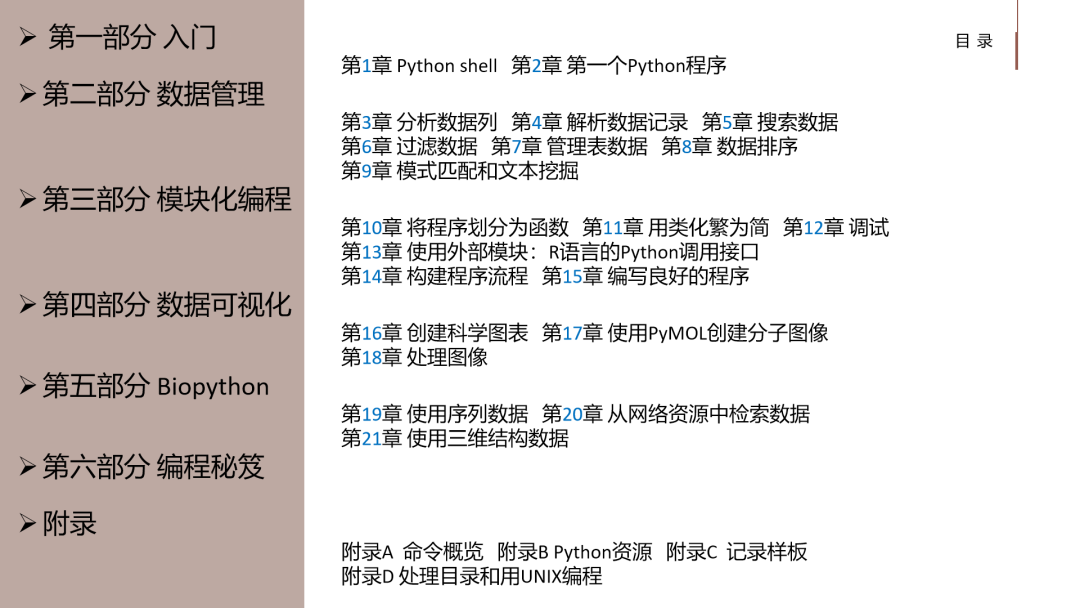
Part2第一部分 入门
下面有些包可能会因为版本原因等各种问题而难以安装,大家可以尝试用conda来装包。
先安装anaconda3:https://mirrors.tuna.tsinghua.edu.cn/help/anaconda/。
注意:
- 安装路径要是英文,然后不要有空格。
- 安装的时候可以选择把anaconda添加到环境变量(虽然它会不推荐你这么做,但是好像还是有挺多人推荐这么做的,后面能省一些事)。
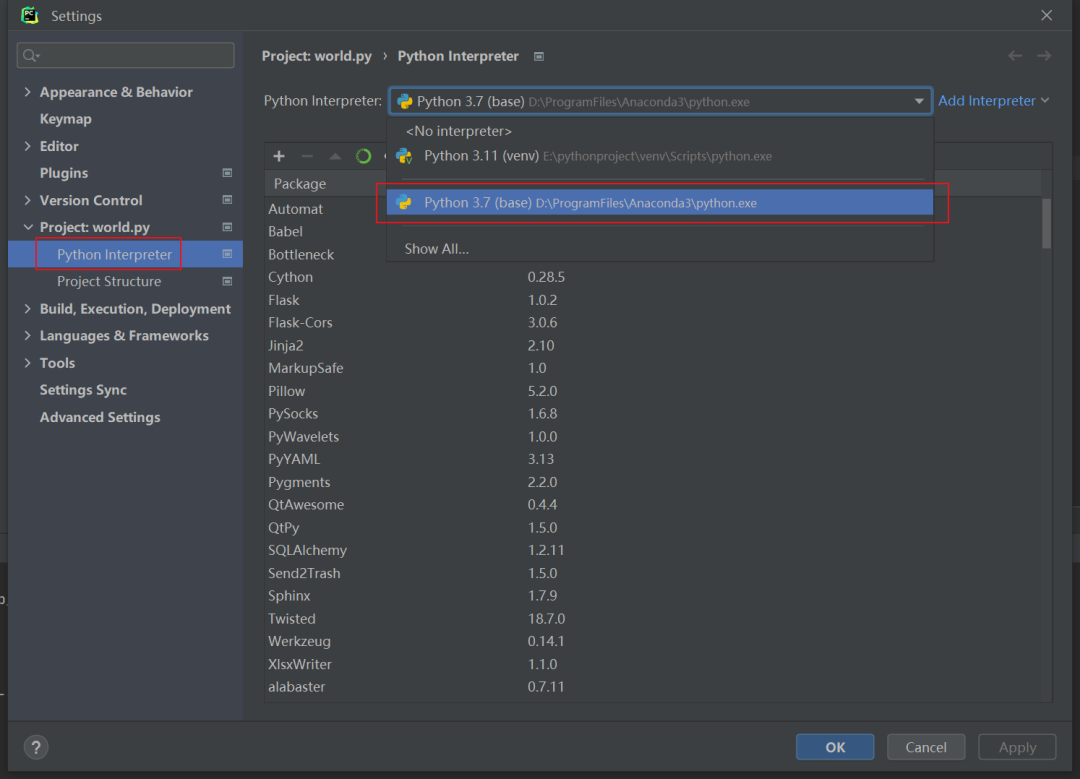
最后再配置一下解释器就可以了
pycharm专业版及一堆大家可能用得到的软件可以在这里面找找:#小程序://冰裤袋/Tfgc07Giqz1Omjs。
装包遇到报错是普遍情况,大部分原因都是因为版本问题。
1第1章 Python shell

Python中的算术运算符

一些math模块中定义的重要函数
2第2章 第一个Python程序
2.2 计算胰岛素序列中的氨基酸频率
insulin = "GIVEQCCTSICSLYQLENYCNFVNQHLCGSHLVEALYLVCGERGFFYTPKT" #胰岛素序列
for amino_acid in "ACDEFGHIKLMNPQRSTVWY": #氨基酸
number = insulin.count(amino_acid) #计算每一个氨基酸在insulin中的数量
print (amino_acid, number)
----------------------------------
A 1
C 6
...
W 0
Y 4
例2.1 创建随机序列
# 从'AGCT'中抽取10个字符
import random
alphabet = "AGCT"
sequence = ""
for i in range(10): #0~9,差一索引
index = random.randint(0, 3)
sequence = sequence + alphabet[index]
print(sequence)
----------------------------------
GCTTCTGGTA #每一次打印出来的结果应该都不一样
#另一种方法
#可重复抽取alphabet中字符
sequence = ""
a=sequence.join([random.choice(alphabet) for i in range(10)])
print(a) #用join函数使之返回字符串类型
----------------------------------
CGGGACGGAA
#不重复抽取alphabet中字符
b = random.sample(alphabet, 4)
print(b) #b为list
----------------------------------
['A', 'G', 'T', 'C']
Part3第二部分 数据管理
3第3章 分析数据列
3.3.5 将数字转换为文本
text = str(100) #处理浮点数时会降低可读性
type(text)
----------------------------------
<class 'str'>
#字符串格式化
'Result:%3i' % (17) #%3i表示格式化为三位的整数
'%8.3f' % (12.3456) #%8.3f表示总字符数为8,小数位数为3的浮点数。
'Hello,%s' % ('Hello,E.coli') #%s表示插入字符串
#%10s表示插入10个字符,且默认为右对齐
#%-10s表示插入10个字符,左对齐
----------------------------------
'Result: 17'
'12.346'
'Hello,E.coli'
#例:
'text:%25s numbers:%4i%4i%5.2f' %('right-justified',1,2,3)
----------------------------------
'text: right-justified numbers: 1 2 3.00'
str.format参考:https://www.runoob.com/python/att-string-format.html
4第4章 解析数据记录
专题4.2 运算符在if条件中的使用
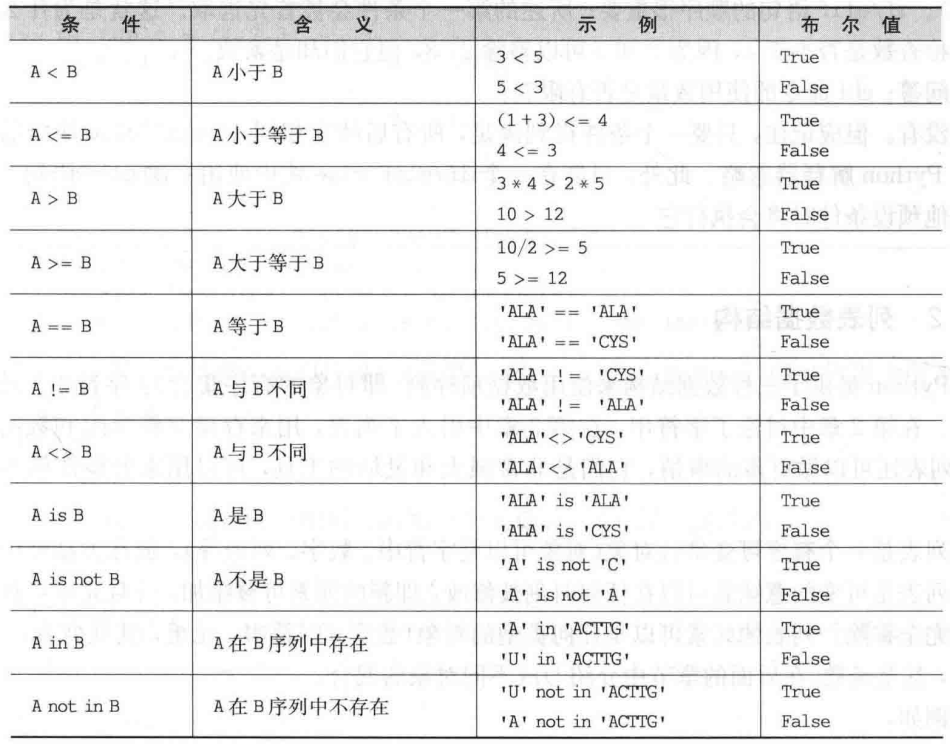
注意:0和空对象对应的布尔值是False
5第6章 过滤数据
6.3.6 集合
#集合是唯一元件的无序组合,不含重复元素
data_a = set([1, 2, 3, 4, 5, 6])
#等价于data_a = {1, 2, 3, 4, 5, 6}
#注意:创建一个空集合必须用 set() 而不是 { },因为 { } 是用来创建一个空字典。
#也等价于data_a = set([1, 1, 2, 3, 4, 5, 6])
data_b = set([1, 5, 7, 8, 9])
#list类型数据需先set()转换成set类型才能进行下述代码
a_and_b = data_a.intersection(data_b) #交集
a_not_b = data_a.difference(data_b) #差:取出data_a独有的元素
b_not_a = data_b.difference(data_a) #取出data_b独有的元素
a_or_b = data_a.union(data_b) #并集
a_xor_b = data_a.symmetric_difference(data_b) #对称差:取出不同时存在于二者的元素
print(a_and_b)
print(a_not_b)
print(b_not_a)
print(a_or_b)
print(a_xor_b)
----------------------------------
{1, 5}
{2, 3, 4, 6}
{8, 9, 7}
{1, 2, 3, 4, 5, 6, 7, 8, 9}
{2, 3, 4, 6, 7, 8, 9}
例6.1 比较两套以上数据集合
import functools as f #reduce()函数已转移至该模块中(Python3.X)
a = {1, 2, 3, 4, 5}
b = {2, 4, 6, 7, 1}
c = {1, 4, 5, 9}
triple_set = [a, b, c]
common = f.reduce(set.intersection, triple_set)
#用传给 reduce 中的函数 intersection 先对triple_set中的、b进行操作,
#得到的结果再与c用 intersection 函数运算,最后得到一个结果。
print(common)
----------------------------------
{1, 4}
6第7章 管理表数据

可对表进行的操作
#像Rstudio一样查看表格
import pandas as pd
table = [
[0.16, 0.038, 0.044, 0.040],
[0.33, 0.089, 0.095, 0.091],
[0.66, 0.184, 0.191, 0.191],
[1.00, 0.280, 0.292, 0.283],
[1.32, 0.365, 0.367, 0.365],
[1.66, 0.441, 0.443, 0.444]
]
B = pd.DataFrame(table)
#结果如下图
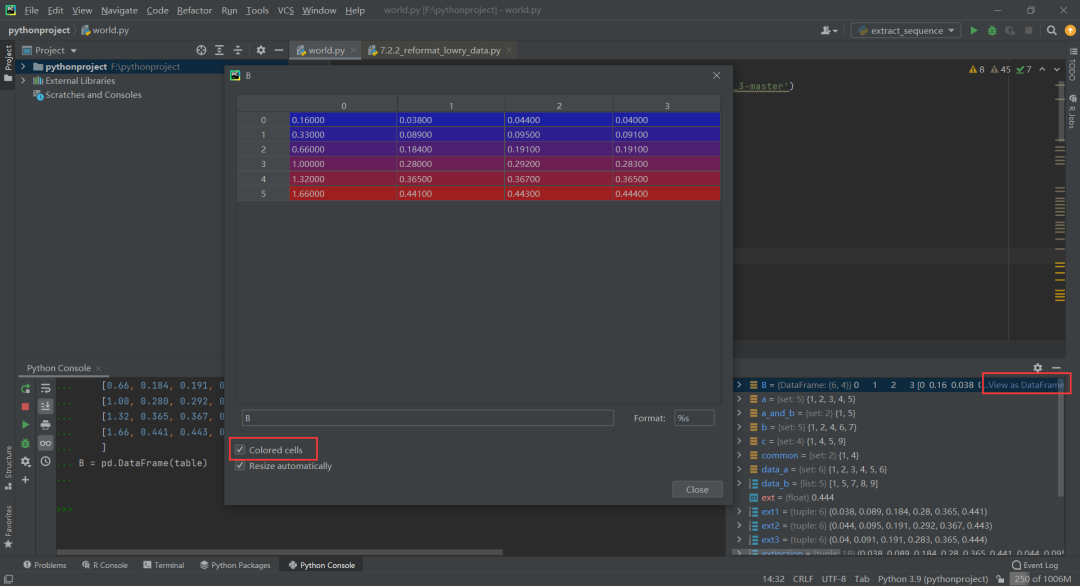
pd.DataFrame(table)
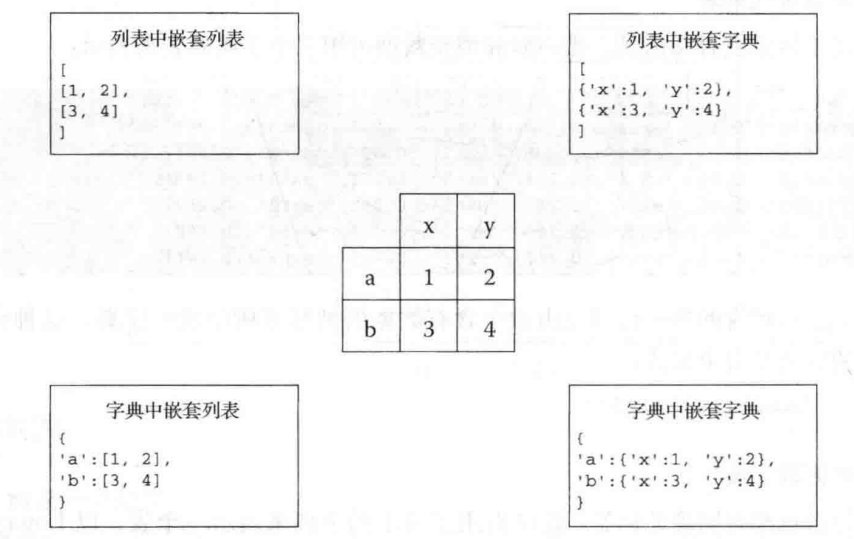
用于存储表的所有方法:嵌套列表、嵌套字典、二者混合
例7.5 将表格数据写入文件
#这个好用,有轮子干嘛不用呢?
import pandas as pd
list1 = [[1,2,3],[4,5,6]]
df = pd.DataFrame(list1)
df.to_csv("test.csv",sep=',',header=False,index=False)
7第8章 数据排序
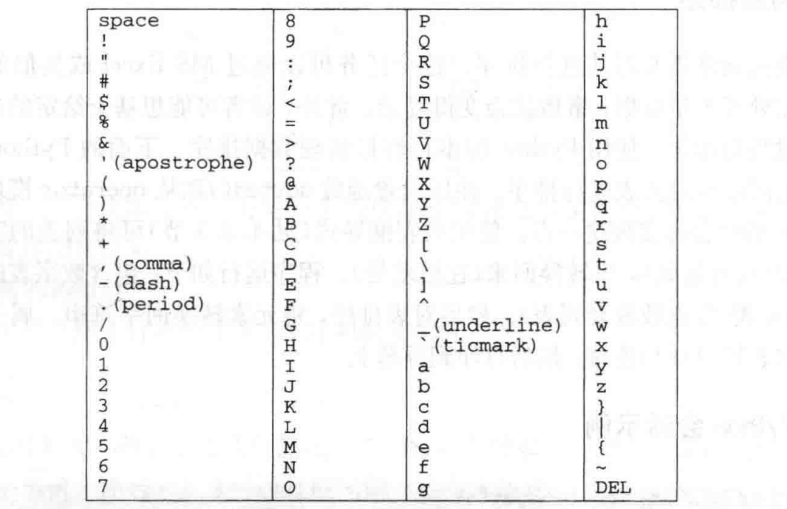
ASCII排序次序图。备注:数字位于字母之前,大写字母位于小写字母之前
8.3.6 按长度对字符串排序
data = ['ACCTGGCCA', 'ACTG', 'TACGGCAGGAGACG', 'TTGGATC']
bylength = sorted(data, key=lambda x:len(x))
#lambda 函数又称匿名函数,不包括 return语句,而是包括一个表达式,
#而且总会返回该表达式的值。
#可以在任何地方定义lambda函数,即便是在未分配名称的另一个函数的参数中。
print(bylength)
----------------------------------
['ACTG', 'TTGGATC', 'ACCTGGCCA', 'TACGGCAGGAGACG']
例8.1 按表格中多列进行排序
import pandas as pd
c=pd.read_table('random_distribution.tsv',header=None)
#这个tsv文件在文末的相关资料中,该文件没有表头,所以header=None
table_sorted = c.sort_values([0,1],ascending=False)
#按表格的第1、2列进行降序排序
print(table_sorted.shape) #查看dataframe的维度
print(table_sorted.head())#查看dataframe的前n行,默认n=6
----------------------------------
(1001, 7) #1001行,7列
0 1 2 3 4 5 6
555 6237 135 0.021645 53 0.008498 283 0.045374
631 6232 102 0.016367 56 0.008986 288 0.046213
656 6216 76 0.012227 50 0.008044 256 0.041184
8第9章 模式匹配和文本挖掘
正则表达式
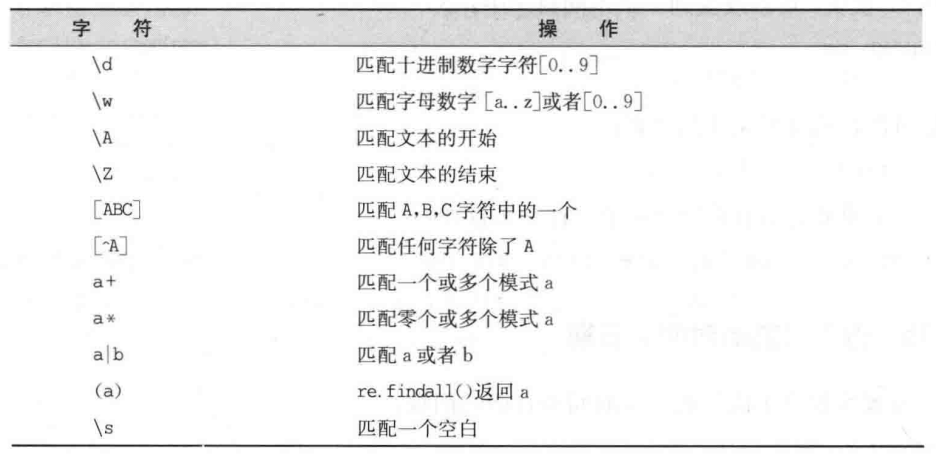
正则表达式模式用到的字符
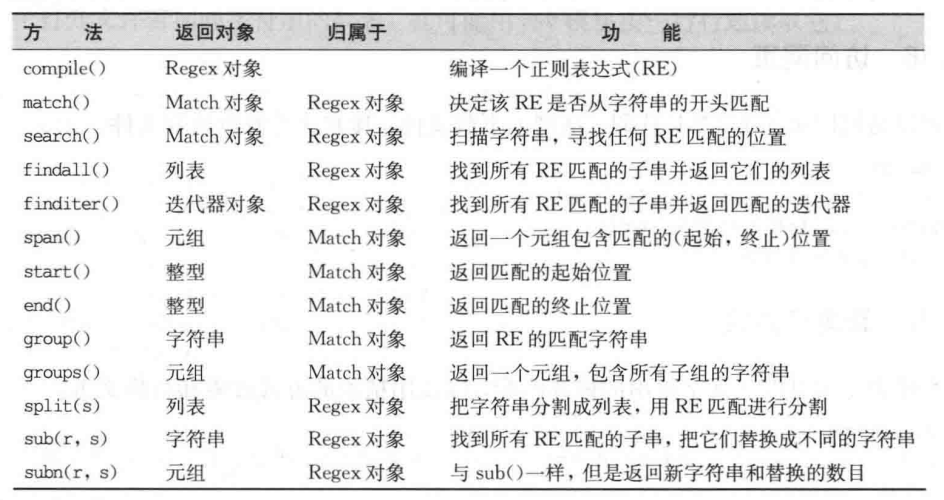
re模块方法

正则表达式编译标志
#例如:
import re
seq = 'RQSAMGSNKSKPKDASQRRRSLEPAENVHGAGGGAFPASQRPSKPrrsl'
pattern = re.compile('R.[ST][^P]',re.I)
#匹配以'R'开头,后一个字符为任意,接下来的字符为'S'或'T',最后不以'P'结尾的字符串。
#'re.I'表示不区分大小写
matches = pattern.findall(seq)
#找到seq中相匹配的所有字符串
print(matches)
----------------------------------
['RQSA', 'RRSL', 'RPSK', 'rrsl']
专题9.1 字符和元字符

重复:*+?{}
Part4第三部分 模块化编程
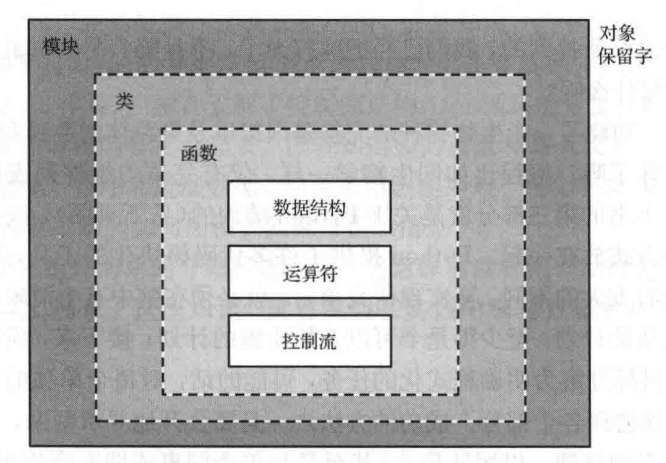
Python结构图
9第12章 调试
异常
- ZeroDivisionError:被零除
- KeyError:键在字典中不存在
- ValueError:类型转换失败
- IOError:文件打不开
- SyntaxError:语法错误
- NameError:名称无法识别
10第13章 使用外部模块:R语言的Python调用接口
本章主要介绍了一下rpy2的使用方法,因为版本原因,我没安装上这个包。但是我们可以通过安装插件R Language for Intellij来实现在pycharm中运行R。
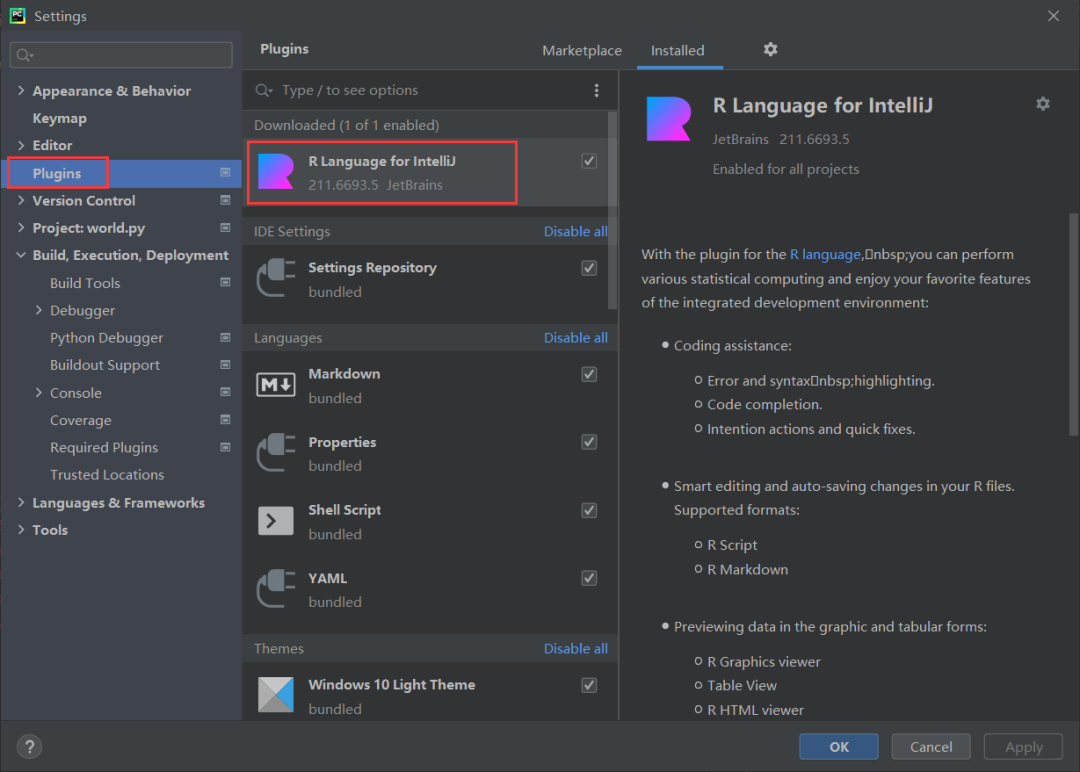
R Language for Intellij
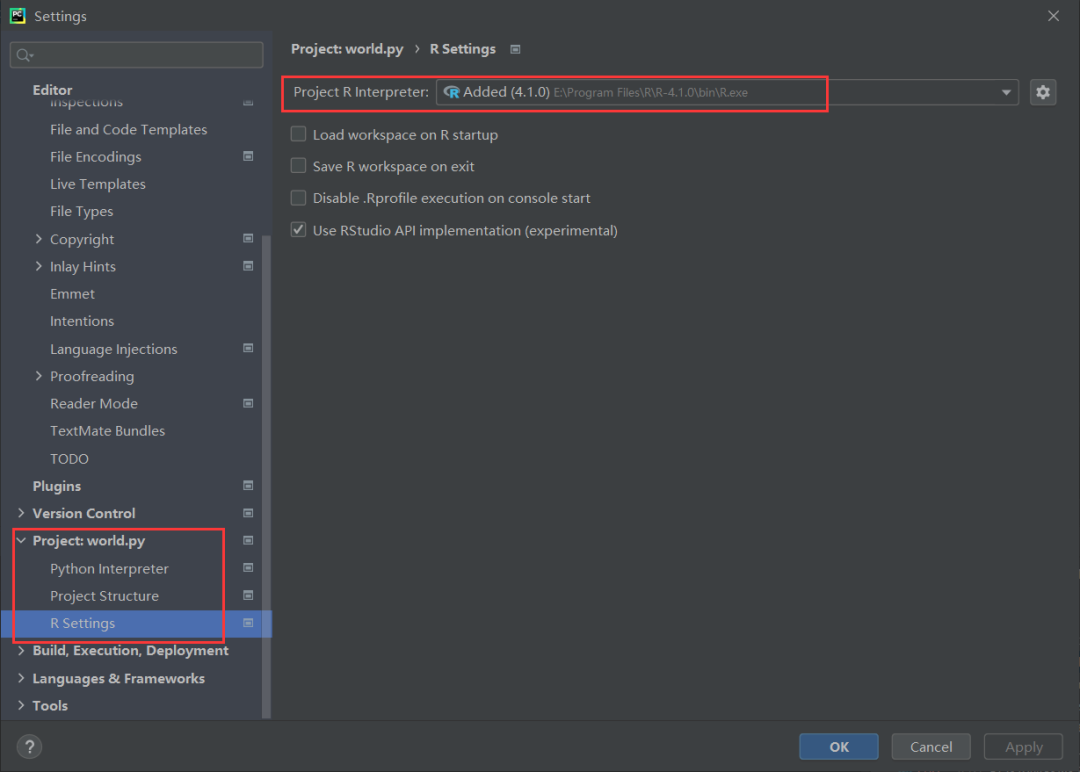
在项目中配置一下R解释器的位置
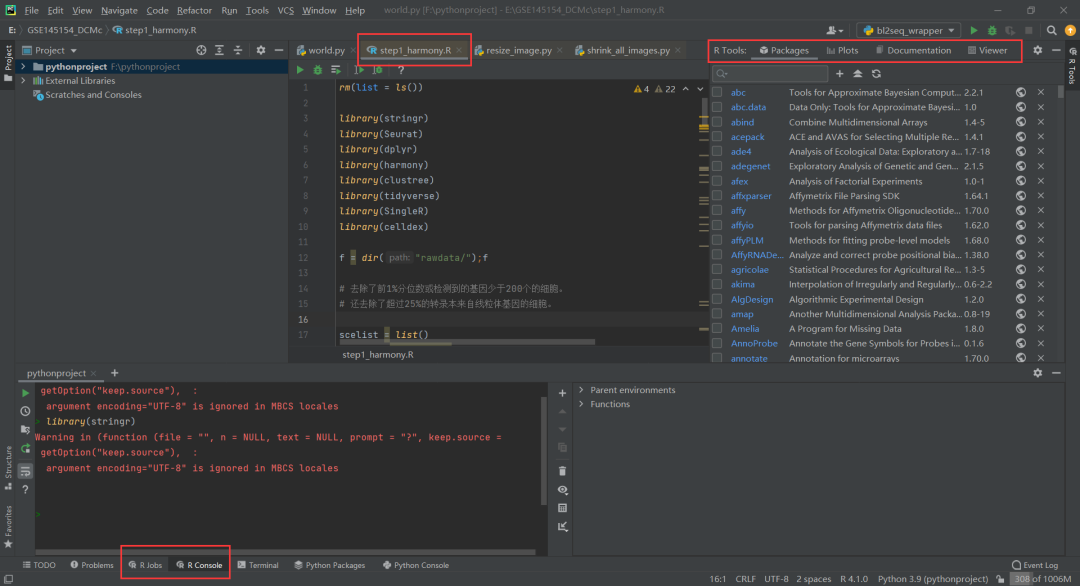
上图就是pycharm中R界面,感觉也还挺好的,就是初始打开的时候,载入相关程序会多花一点时间。
和Rstudio相比,我更喜欢pycharm的写代码的界面,但是好像需要在某个项目中才能正确地打开pycharm。Rstudio就比较随意了,它的解释器路径相对固定,不管在哪个路径下打开R文件,都能直接跑。
11第15章 编写良好的程序
例15.2 创建自己的包
比如我们想创建一个名为neuroimaging的包,我们需要将模块存储在同一个地方,就可以将模块集合成包。
文件夹的目录neuroimaging/ #该目录下包含我们所写的模块
neuron_count.py
shrink_images.py
_init_.py #为了让包可以导入,需要添加该文件
#该文件可以是空的
#_init_.py文件可由以下三个命令自动导入
import neuroimaging
from neuroimaging import neuron_count
from neuroimaging.shrink_images import *
Part5第四部分 数据可视化
12第16章 创建科学图表
#我找到了一个感觉比较好的画图包:plotly
#运行下面的代码需要先用pip安装plotly和plotly-express
#找了一个plotly画图的例子:
import plotly_express as px #这个包里有很多数据可以用来画图
gap = px.data.gapminder().query("year == 2002")
fig = px.scatter(
gap # 绘图数据
,x="gdpPercap" # x轴
,y="lifeExp" # y轴
,color="continent" # 颜色参数
,size="pop" # 点的大小
,size_max=60 # 点的最大值
)
fig.show()
#画出了一张交互式的图。
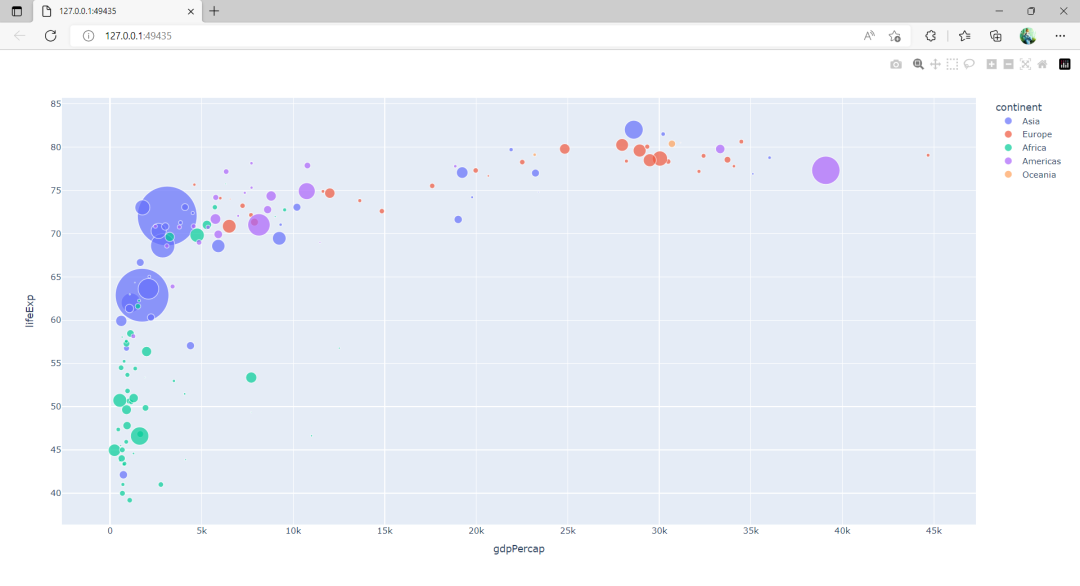
气泡图
更多图表参考:
https://github.com/plotly/plotly.py
https://plotly.com/python/
13第18章 处理图像
专题18.2 常用的图像格式有什么不同
- BMP:这种格式实际上是像素的简单表。这就是文件非常大的原因。
- PNG:这种格式保留了每个像素的颜色。当图像转换为PNG格式时,可以确保不会丢失任何信息。PNG图像可以是部分透明的。
- GIF:GIF类似于PNG,但是更早。GIF图像可以是动态的(这曾经在网络发展的早期流行,但已经过时)。
- JPG:这种强力压缩的格式通过将相邻像素的颜色模糊一些的方式来节省空间。这对照片是很好的,但会破坏线条图像的精确性。
- TIF:TIF有一个准确的像素格式,使得文件比PNG大得多。LZW压缩方式很流行。这种格式常用于设计工作和其他平面媒体。
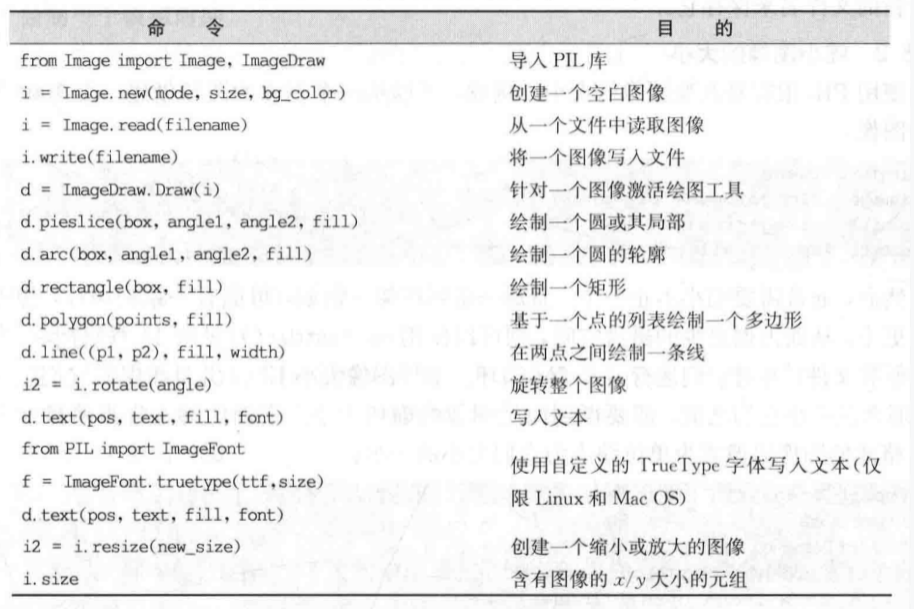
绘制和处理图像的Python命令
例18.1 将几张图片组合成一个单独的图像
from PIL import Image
image = Image.open('color.png', 'r')
label = Image.open('label.png', 'r')
image.paste(label, (40, 460)) #(40, 460)为label的位置,默认为(0,0)
#(0,0)为image的左上角。
image.save('combined.png')
#结果如下
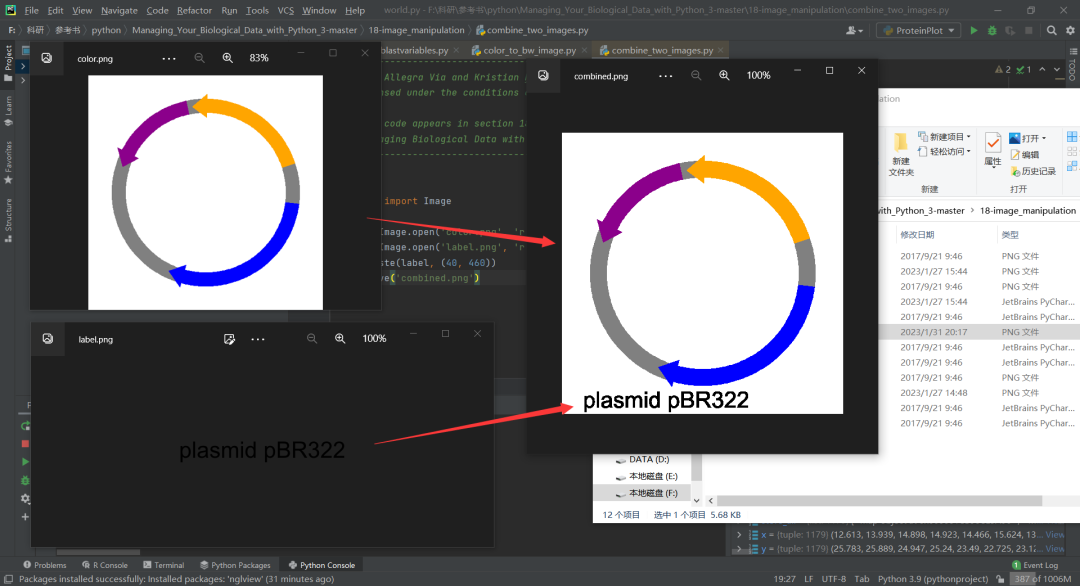
例18.3 将一个彩色图像变为黑白图像
from PIL import Image
image = Image.open('color.png', 'r')
bw_image = Image.new('LA', image.size, (255, 255)) #创建一张空图像
#'LA'表示单色模式
#(255, 255)为图像填充的颜色
bw_image.paste(image, (0, 0))
bw_image.save('black_white.png')
Part6第五部分 Biopython
更多biopython知识参考:
https://biopython.org/wiki/Documentation
14第19章 使用序列数据
19.2 将一条DNA编码序列翻译成对应的蛋白质序列,并把它写入FASTA文件
#代码有所改变,参考:https://biopython.org/wiki/Alphabet
from Bio import Seq
from Bio.SeqRecord import SeqRecord
from Bio import SeqIO
# read the input sequence
dna = open("hemoglobin-gene.txt").read().strip() #该文件内容为一条DNA编码序列
dna = Seq.Seq(dna)
#Seq对象为不可更改序列,mutableSeq对象为可变序列对象
# transcribe and translate
mrna = dna.transcribe() #转录
protein = mrna.translate() #翻译
# write the protein sequence to a file
protein_record = SeqRecord(protein, id='sp|P69905.2|HBA_HUMAN',
description="Hemoglobin subunit alpha, Homo sapiens")
outfile = open("HBA_HUMAN.fasta", "w")
SeqIO.write(protein_record, outfile,"fasta")
#SeqIO.write可将多个SeqRecord对象写入指定文件
outfile.close()
HBA_HUMAN.fasta #该输出文件内容如下
----------------------------------
>sp|P69905.2|HBA_HUMAN Hemoglobin subunit alpha, Homo sapiens
MVLSPADKTNVKAAWGKVGAHAGEYGAEALERMFLSFPTTKTYFPHFDLSHGSAQVKGHG
KKVADALTNAVAHVDDMPNALSALSDLHAHKLRVDPVNFKLLSHCLLVTLAAHLPAEFTP
AVHASLDKFLASVSTVLTSKYR*
15第20章 从网络资源中检索数据
20.2 在 PubMed 中用关键词搜索文献,下载并解析对应的记录
Biopython访问NCBI网络服务的模块又称Entrez,用来访问和下载NCBI数据记录。近一步的解析文献记录,需要一个模块Bio.Medline中的特定解析器。
#具体文档可参考:https://www.ncbi.nlm.nih.gov/books/NBK25499/
from Bio import Entrez
from Bio import Medline
keyword = "PyCogent"
# search publications in PubMed
Entrez.email = "my_email@address.com"
#如果出现问题,NCBI可通过邮件联系你,但是这个是非强制性的
handle = Entrez.esearch(db="pubmed", term=keyword) #在NCBI中搜索
#更多db可参考:https://www.ncbi.nlm.nih.gov/books/NBK25497/table/chapter2.T._entrez_unique_identifiers_ui/?report=objectonly
record = Entrez.read(handle)
pmids = record['IdList']
print (pmids)
# retrieve Medline entries from PubMed
handle = Entrez.efetch(db="pubmed", id=pmids, rettype="medline", retmode="text")
#从NCBI服务器上下载记录
medline_records = Medline.parse(handle) #解析下载的记录
#如果需要解析单个记录,则可使用Medline.read()函数,而不是Medline.parse()。
records = list(medline_records)
n = 1
for record in records:
if keyword in record["TI"]:
print (n, ')', record["TI"])
n += 1
----------------------------------
['22479120', '18230758', '17708774']
1 ) Abstractions, algorithms and data structures for structural bioinformatics in PyCogent.
2 ) PyCogent: a toolkit for making sense from sequence.
例20.5 检索SwissProt数据库条目并把它们写入一个FASTA格式的文件
#Biopython提供了一个模块(称为ExPASy)来访问SwissProt数据库和其他的Expasy资源
from Bio import ExPASy
from Bio import SeqIO
#下述代码只能同时对一个SwissProt的AC进行处理,
handle = ExPASy.get_sprot_raw("P04637")
seq_record = SeqIO.read(handle, "swiss")
print (seq_record.id)
print (seq_record.description)
#可用for循环逐个检索和解析它们。
out = open('myfile.fasta','w')
fasta = SeqIO.write(seq_record, out, "fasta")
out.close()
16第21章 使用三维结构数据
21.2 从PDB文件中提取原子名及其三维坐标
#Bio.PDB包可用来从网络上检索大分子结构,读写PDB文件,计算原子间的距离和角度,叠加结构。
from Bio import PDB
from Bio.PDB import PDBIO
pdbl = PDB.PDBList()
pdbl.retrieve_pdb_file("2DN1") #下载pdb结构
parser = PDB.PDBParser() #解析pdb结构
structure = parser.get_structure("2DN1", "dn/pdb2dn1.ent")
#Structure对象是一个容器,存储PDB数据项中的结构信息,
#这个层次结构可以被简写为SMCRA(Structure→Model(s)→Chain(s)→Residues→Atoms)。
#parser = MMCIFParser() #解析mmCIF文件
#structure = parser.get structure("2DN1","2DN1.cif")
for model in structure:
for chain in model:
print (chain) #打印链
for residue in chain:
print (residue.resname, residue.id[1]) #打印残基及其序列标识
for atom in residue:
print (atom.name, atom.coord) #打印原子及其坐标
# write pdb file
io = PDBIO()
io.set_structure(structure)
io.save('my_structure.pdb') #将structure对象保存到文件
例21.1 计算原子间的距离
from Bio import PDB
parser = PDB.PDBParser()
structure = parser.get_structure("2DN1","dn/pdb2dn1.ent")
#pdb2dn1.ent文件在/dn文件夹中
atom1 = structure[0]['A'][2]['CA']
atom2 = structure[0]['A'][3]['CA']
dist = atom1 - atom2
print (dist)
----------------------------------
3.7660766
Part7附录
17附录A 命令概览
A.2.4 运算符

修改变量
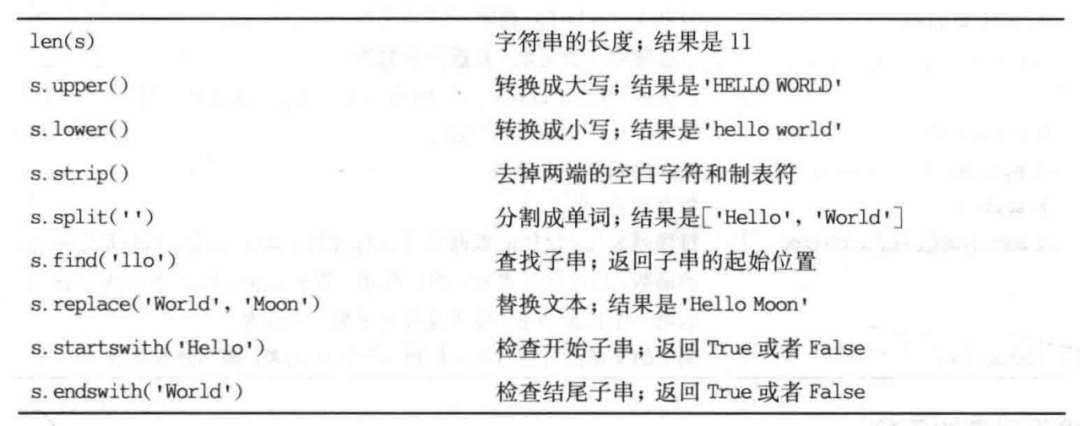
字符串函数
A2.12

找出模块中有什么
18附录B Python资源
B.4 其他Python库
- Matplotlib
http://matplotlib.org/这是一个强大的创建图表的库,是Python科学库(SciPy)的一部分。 - Python Imaging Library(PIL)
www.pythonware.com/products/pil/PIL是一个操纵图片的通用库。 - PyCogent
http://pycogent.org/PyCogent是一个有很多功能的生物学库,很多方面类似Biopython,但它的优势是处理RNA和系统发生学分析。(在windows上比较难运行) - ModeRNA
http://iimcb.genesilico.pl/moderna/ModeRNA是一个检察、处理和建立RNA结构三维模型的Python库。
Part8写在文末
这本书里面也提到了很多的生信相关软件,
我主要记录了一些python的相关知识。
很多知识我也正在学习中。
理论加实践才是学习知识的最好方法,学习了这些Python基础我们就可以放手去做了,在后续的实践中不断完善自己的不足之处。
参考资料
- Python生物信息学数据管理/(意)阿莱格拉·维亚(Allegra Via)等著;卢宏超等译.一北京:电子工业出版社,2017.1
